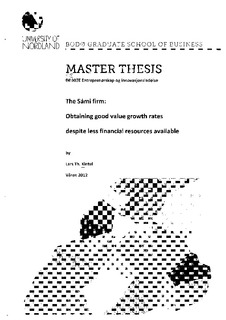| dc.description.abstract | This Master thesis investigates differences in access to financial capital and consequences for
company valuation among Sami and non-Sami companies in North Norwegian Sami regions. Access
to capital is very important both for the entrepreneurs seeking value growth and dividends from
their investment, and for the ability to exploit growth potential in these regions. In order to
determine if special capital initiatives should be develop for the Sami regions, this research
investigate if Sami, non-Sami, or both categories of companies, experience capital scarcity reducing
growth in value and ability to exploit business opportunities. Differences is measured with regards to
company financial value growth, market expansion orientation, level of private equity invested, and
the use of network as source of finance. The aim is to reveal variations and similarities between Sami
and non-Sami owned companies present in the same business environment.
The thesis reveals that there are only marginal differences between Sami and non-Sami companies
with regards to value growth. Sami companies have a Httie less invested equity and limited CEO
network, but there were no significant differences between financial value growth, geographical
market orientation and number of owners between these groups of companies.
The results showa significant correlation between the amount of invested equity and financial
growth for Sami companies, but not for non-Sami companies. One implication is that Sami companies
experience lack of financial capital compared to Non Sami firms. There is also a significant correlation
between geographica! market orientation and growth in firm value for non-Sami companies, but not
for Sami. There was no significant correlation between network and financial growth for the
companies in the selection. The reason might be that many of these companies are in service
industries and seil directly to private customers, and hence need fewer contacts in the professiona!
business life.
The thesis finds that despite comparably less Invested Equity leve Is are Sami companies growing at
the same rate as non-Sami. Two major implications can be drawn. In order to stimulate value
creation and growth, one should establish initiatives improving access to financial capital for al!
companies in Sami regions. Sami companies wHI benefit the most from this, but the growth potential
in these regions could be much better utilized. The second major impiications, is that the market
proves to be a strict selection mechanism, making capita! access a problem for aH companies in Sami
regions. | |
